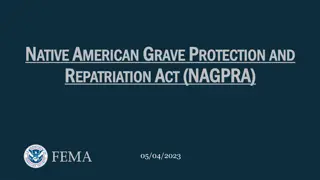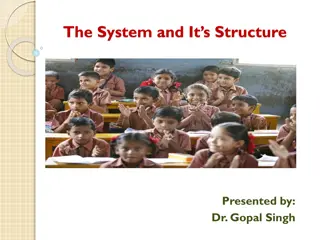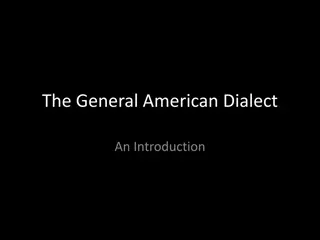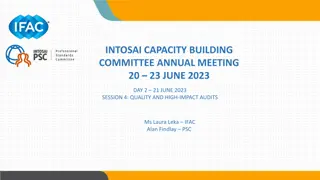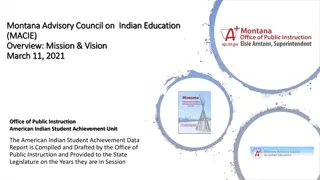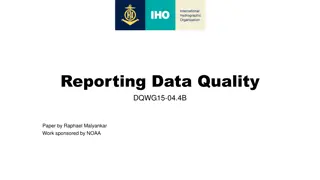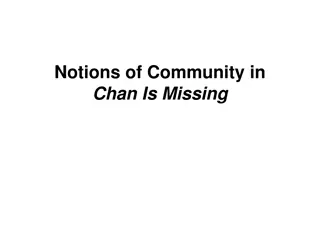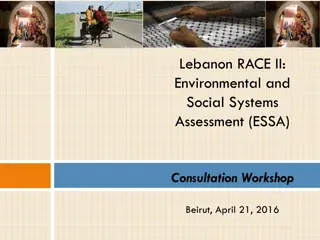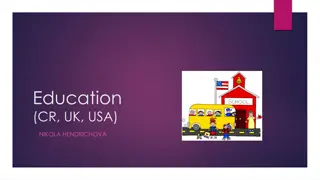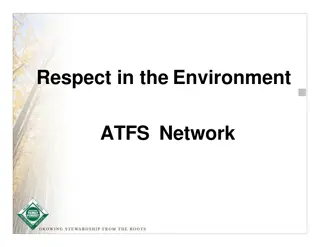Overview of American Education System and Quality
Education in America involves government participation at all levels, with each state having control over its education system. Students begin formal education at kindergarten, progressing through elementary and secondary school. The system culminates with post-secondary education, though this is not free. While the system has high participation rates and a significant number of graduates, there are still challenges, including a portion of the adult population with limited literacy skills.
Download Presentation

Please find below an Image/Link to download the presentation.
The content on the website is provided AS IS for your information and personal use only. It may not be sold, licensed, or shared on other websites without obtaining consent from the author.If you encounter any issues during the download, it is possible that the publisher has removed the file from their server.
You are allowed to download the files provided on this website for personal or commercial use, subject to the condition that they are used lawfully. All files are the property of their respective owners.
The content on the website is provided AS IS for your information and personal use only. It may not be sold, licensed, or shared on other websites without obtaining consent from the author.
E N D
Presentation Transcript
AMERICAN COUNTRY & CIVILIZATION STUDY Nguyen Thi Thanh Thanh, M.A. Lecturer of University of Foreign Language Studies, The University of Danang
AMERICAN EDUCATION Nguyen Thi Thanh Thanh, M.A. Lecturer of University of Foreign Language Studies, The University of Danang
EDUCATION The government and education All levels of government are involved in education one of their most important responsibilities. The federal government provides some money for education through the Department of Education. But state and local governments have direct control and are responsible for the education of students from kindergarten, first grade, second grade, etc. to twelfth grade.
EDUCATION The government and education States are also concerned with certification standards, general standards of education including the qualifications needed by teachers At the primary and secondary levels, most school districts have a Parent-Teacher Association (PTA) which gives all parents a chance to take part in making decisions about how the school is run.
The school system Nursery school, day care or pre-school from an early age, Formal education is usually considered to begin at the age of 5 when children go to kindergarten, the first step in the K 12 education. Kindergarten and the next five or six years of education, first grade, second grade, etc., : elementary school (the term primary school is less common in the US than in Britain).
The school system Grades seven to twelve are part of secondary school, and may be divided in different ways. Grades seven and eight are called junior high school. Other school systems have middle school (lasts for three years) High school usually covers 4 years, (9th 12thgrades) Post-secondary education, after twelfth grade, is not free though state governments.
The quality of education By some standards, American education seems very successful. Although young people must attend school until they are 16, over 80% continue until they are 18. About 45% of Americans have some post-secondary or further education, and over 20% graduate from a college or university. However, 20% of adults, about 40 million people, have very limited skills in reading and writing, and 4% (8 million) are illiterate (= cannot read or write).
The quality of education Education quality varies greatly from place to place. The most important reason is money. In general, the people who live in city centres tend to be very poor. Those with more money prefer to live in the suburbs. People in the suburbs pay higher taxes, and so the schools there have more money to spend. Crime and violence are also serious problems in the inner cities, with some students taking weapons to school. In such a situation it is hard to create a good atmosphere for learning.
Public or private education Most educational institutions in the US are public but there are some private schools (students pay a lot of money to attend). Many private schools have a high reputation and parents send their children there so that they will have advantages later in life. Most parents who have money are likely to spend it not by sending their children to private schools but by moving to a suburb where the public schools are good
Practice Define the following words, using a dictionary if necessary. school board superintendent principal PTA further education
Practice Define the following words, using a dictionary if necessary. school board a board has control over how a school is run superintendent a person who has a lot of authority and manages schools in a district principal (the person who is in charge of a school PTA (Parent-teacher Association further education any education after secondary school
Practice Write T for true and F for false. Correct the false statements .Education is a federal responsibility. .The state pays for a K-12 education. .The Boards of Education decide standards of certification and teacher s qualifications. .Boards of education employ principals and teachers . .The PTA runs the school. .Compulsory education starts with first grade. .Students may leave school at the age of sixteen. .The quality of education varies from place to place. .The difference in quality between city and suburban schools is a big issue. .Public schools in the city centers are better than those in the suburban areas.
Practice Write T for true and F for false. Correct the false statements F .Education is a federal responsibility. T .The state pays for a K-12 education. T .The Boards of Education decide standards of certification and teacher s qualifications. T .Boards of education employ principals and teachers . F .The PTA runs the school. F .Compulsory education starts with first grade. F .Students may leave school at the age of sixteen. F .The quality of education varies from place to place. F .The difference in quality between city and suburban schools is a big issue. F .Public schools in the city centers are better than those in the suburban areas.
School grades LEVEL Elementary Middle school High school GRADE AGE 5- 12 (Kindergarten-6) 7-8 (9-12) (11-14) . (14-18)
Life in elementary school The school year runs from early September to the following June. Students attend daily from Monday to Friday. The school day in elementary school usually lasts from about 8.30 a.m. to 3.30 p.m., though kindergarten children usually attend for only half the day. Students spend most of the day with their class. The class is taught most of the time by the same teacher. A few times each week they will have a gym class or do music or art with another teacher. Students rarely have homework.
Life in elementary school The school day is divided into various sections In the morning and the afternoon students have recess, a time when they can go outside and play (about 15 minutes). In the middle of the day students eat lunch. The rest of the lunch period is free and spent playing. The traditional subjects for elementary school students are called the three Rs: reading, writing, and arithmetic. In addition, the students study other subjects, such as history and geography, and are given a chance to do creative activities and sports.
Life in elementary school Teachers are rather relaxed about the kind of behaviour they expect from students at elementary school. Students at public schools do not usually have a school uniform. Students who attend private and parochial (= religious) schools do wear uniform.
Junior high school and high school Students take different lessons from different teachers who are specialists in their subjects. Students are required to study certain subjects, but they can choose which classes they take. There are also many subjects that students can choose to do or to drop, without any limits at all.
Junior high school and high school Students may take technical subjects: such as computer programming alongside academic subjects. When graduating from high school, students receive a diploma (a document to say that they have finished their courses). An important part of junior high school and high school is the increasing amount of independence and responsibility they are given.
Junior high school and high school Students in high school have special names: ninth-grade students are called freshmen; tenth-graders are sophomores; students in the eleventh grade are juniors, and those in the twelfth grade are seniors.
GOING TO COLLEGE Americans talk about going to college even if the institution they attend is a university. To Americans the phrase going to university sounds pretentious. Most colleges offer classes only for undergraduate students studying for a bachelor s degree. Community colleges offer two-year courses leading to an associate s degree, and afterwards students transfer to a different college or university to continue their studies. Universities are larger than colleges and also offer courses for graduate students who study in graduate school. Many universities also have separate professional schools, e.g. a medical school or a law school.
GOING TO COLLEGE to study at a college or university, students have to take a standardized test, e.g. the SAT (Scholastic Aptitude Test) or the ACT (American College Test). Students from countries outside the US who are not native speakers of English must also take the TOEFL (Test of English as a Foreign Language). Each college or university decides on the minimum score it will accept, though test scores are never the only factor taken into account. Students apply direct to between three and six colleges in their last year of high school.
GOING TO COLLEGE There are many private colleges and universities but most students choose a public institution because the costs are lower. Students whose families cannot afford to pay the full amount apply for financial aid. Many students receive a financial aid package which may be a combination of grants from the government, a scholarship, a student loan and work-study (= a part-time job at the college). Large universities often put most emphasis on research. Smaller colleges tend to concentrate on teaching undergraduates
Sources Oxford Guide to British and American Culture, OUP 1999 Wikipedia - The free Encyclopedia http://en.wikipedia.org/wiki/United_States Suggested reading A Diverse Educational System, Portrait of the USA, published by the United States Information Agency, 1979 http//usinfo.state.gov/usa/infousa/facts/factover/homepag e.htm
THANK YOU FOR YOUR LISTENING







